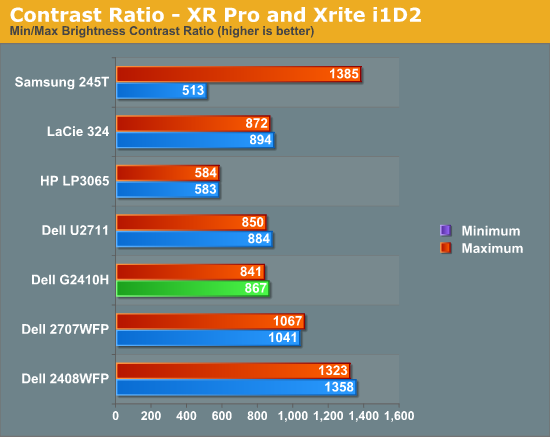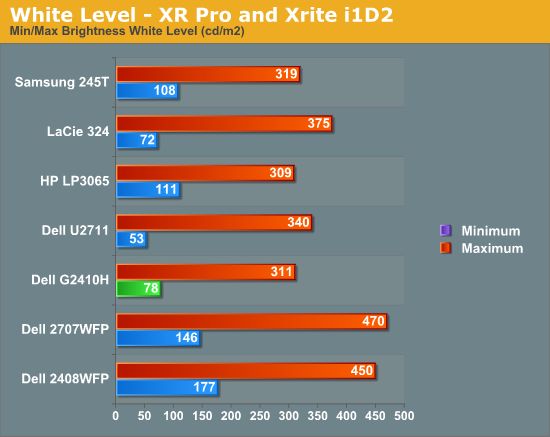Dell G2410H Review: A Green 24" LCD
by Brian Klug on May 7, 2010 1:43 AM EST
White and Black points, Contrast
For brightness, black level, and contrast points, we use the same colorimeter setup described earlier. Specifically, an Xrite i1D2 with ColorEyes Display Pro, and take measurements. Dynamic contrast is always turned off, as this throws off our results. We also let the panels settle in for a half hour at the respective settings before taking any measurements, though with WLED the wake up time is much shorter than a CCFL.



Black level is an important metric, since it directly represents the extinction ratio of the crossed polarizers in the TN cells. Remember, when a pixel is desired to be black, the photoelectric crystal in the cell changes linearly polarized light 90 degrees out of phase, so it is blocked by the polarizer. Higher extinction ratios (and thus better crystals and materials) result in lower (better) black levels.
We recommend running monitors at around 200 nits of luminous intensity, just because this is often where some of the best color tracking sits, and it’s enough of a balance to not result in eye stress from looking around the room and having your pupil adjust. As an aside, I personally am a bit of a light-crazy person and usually crank my displays brightness to the max (I consider 400 nits normal), but forget that I ever said that. ;)
The charts show the dynamic range in brightness, and the respective black levels at each brightness. What we’re really interested in, however, is the contrast ratio. We can see pretty quickly that the G2410H doesn’t meet the advertised 1,000 ratio, but comes close at 867. Performance is pretty consistent as well at both brightness settings.
It’s interesting that the WLED backlit G2410H doesn’t blow the CCFL backlit displays out of the water at maximum brightness. More than likely, Dell has engineered a display that uses as few LEDs as possible for the sake of power savings. The tradeoff there is that maximum intensity isn’t as high. For an eco-conscious monitor, we’re willing to accept that.










39 Comments
View All Comments
tno - Friday, May 7, 2010 - link
"unless you’re using an HDMI to DVI cable, you should be running the LCD at native resolution."I am currently using two HDMI to DVI cables in my HT set-up. HTPC (DVI) to receiver (HDMI) and receiver (HDMI) to old Sony XBR 1080i (DVI). This is all HDCP comliant so I don't have any issues. Since I'm moving very far away I will be leaving my tried and true Sony and in the interim between moving and getting a NEW TV I picked u a rather cheap OLD TV (Dell W3000). This older model does not have HDMI either so I will still be using an HDMI to DVI cable. Is this a bad thing?
I'm running at 720p out of the PC on this 13//x768 dislay? Will this be a problem? Should I set the PC to the native rez? Thanks for the article BTW. Great job. I have loved my CRTs, (the XBR plus a behemoth 2048x1536 NEC model for my PC) and hung to them more because of the bargains that they were. I gladly traded the exertion required to lift them for the cheap price and better PQ was just bonus. But the prospect of moving them has lessened their appeal so I will be tube free from now on.
tno
quiksilvr - Friday, May 7, 2010 - link
I'll state what I stated before when I commented on the release of the G2410 and heard about these "letdowns".Ahem...
If there are no speakers, WHY DO YOU NEED HDMI? It has HDCP compliant DVI-D. Just spend the whopping $5 and get the DVI-D to HDMI adapter. It's not like this thins is 2560x1400. Its a run of the mill 1080p screen.
aftlizard - Friday, May 7, 2010 - link
Why do I need HDMI if I don't need audio? Because I don't want to spend the extra money if I don't have to. If I have the cable already or want to spend money on the cable I can find hdmi cables cheaper than a converter or even an hdmi-dvi cable.aftlizard - Friday, May 7, 2010 - link
Why do I need HDMI if I don't need audio? Because I don't want to spend the extra money if I don't have to. If I have the cable already or want to spend money on the cable I can find hdmi cables cheaper than a converter or even an hdmi-dvi cable.james.jwb - Friday, May 7, 2010 - link
Next monitor upgrade: 24-inch or larger, IPS or better, 120 Hz performance.When that comes I'll be happy ;)
JarredWalton - Friday, May 7, 2010 - link
I don't know that anyone has done IPS (or PVA/MVA for that matter) at anything above 60Hz. I could be wrong, I freely admit this, but virtually every 120Hz display I've heard about was a TN panel. Blech. When you consider the pixel response times, though, it starts to make a bit of sense. 120Hz should be doable with the 6ms IPS panels, but the 2ms TN panels might switch a bit faster. (Note that in our testing, even the 2ms TN panels still show much 2-3 frames.)Anyway, I'm with you. I'd like 120Hz IPS, with a high resolution 30" panel. LOL. I think I'd need quad-link DVI to do that.
james.jwb - Friday, May 7, 2010 - link
display port should do it?svojoe - Friday, May 7, 2010 - link
for off griders like myself this is sooooo awesome. 13 watts! Holy crap thats such low power consumption I can not feel bad about draining down my batteries!Brian Klug - Saturday, May 8, 2010 - link
Out of curiosity, are you on a PV system or something else? I'm moving into a place that's entirely solar powered with a 1:1 PV offset. I'm glad there's someone out there excited by the prospect of a low-power monitor, I mean, 11 watts still is impressive to me as well. Especially considering the brightness you get for that amount of power.-Brian Klug
Porksmuggler - Saturday, May 8, 2010 - link
Thanks for putting the panel type TN on the first page. $339 for a TN with no HDMI, no thanks. The 1080P isn't puzzling at all, it's all about saving on panel cost. Anyone feel like doing the math on how long you would have to use this "green" LCD to make up for the sticker bloat?